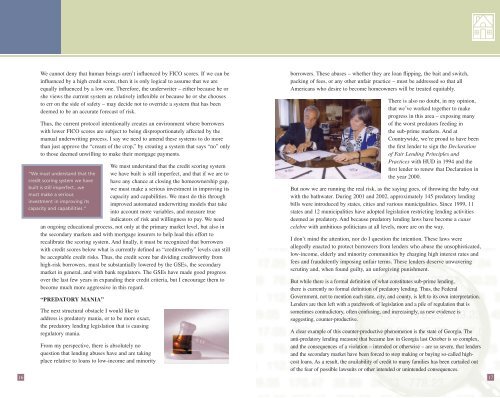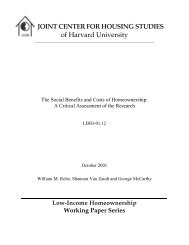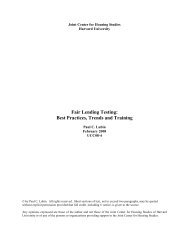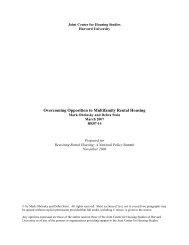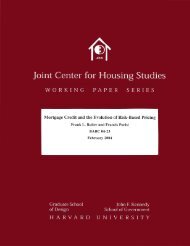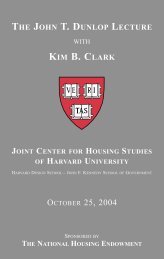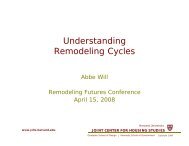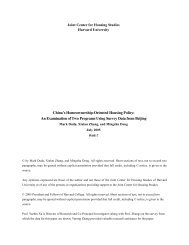The American Dream of Homeownership: From Cliché to Mission
The American Dream of Homeownership: From Cliché to Mission
The American Dream of Homeownership: From Cliché to Mission
Create successful ePaper yourself
Turn your PDF publications into a flip-book with our unique Google optimized e-Paper software.
As President Bush said last Oc<strong>to</strong>ber:<br />
“THE HOMEOWNERSHIP GAP – WHY IT EXISTS”<br />
8<br />
“Two thirds <strong>of</strong> all <strong>American</strong>s own their homes, yet we have a<br />
problem here in America because fewer than half <strong>of</strong> the Hispanics<br />
and half <strong>of</strong> the African <strong>American</strong>s own their home. That’s a<br />
homeownership gap. It’s a gap that we’ve got <strong>to</strong> work <strong>to</strong>gether <strong>to</strong><br />
close for the good <strong>of</strong> our Country, for the sake <strong>of</strong> a more hopeful<br />
future. We’ve got <strong>to</strong> work <strong>to</strong> knock down the barriers...”<br />
While the number <strong>of</strong> minority homeowners has advanced recently, climbing from<br />
9.5 million in 1994 <strong>to</strong> 13.3 million in 2001 – an increase <strong>of</strong> 40 percent – the fact<br />
remains that it is still not at a level equal <strong>to</strong> that <strong>of</strong> white homeownership. And as<br />
President Bush pointed out, the homeownership rate for African <strong>American</strong>s is 47<br />
percent and for Hispanic <strong>American</strong>s it is 48 percent, a stark contrast <strong>to</strong> the<br />
homeownership rate <strong>of</strong> 75 percent for white <strong>American</strong> households.<br />
That means there is currently a homeownership gap <strong>of</strong> over 25 points when<br />
comparing white households with African <strong>American</strong>s and Hispanics. My friends,<br />
that gap is obviously far <strong>to</strong>o wide. It has been far <strong>to</strong>o wide for far <strong>to</strong>o long. And<br />
when adding new fac<strong>to</strong>rs in<strong>to</strong> the equation – like an influx <strong>of</strong> new immigrants or<br />
continued reduction in the supply <strong>of</strong> affordable housing – it has the potential <strong>to</strong><br />
become far worse.<br />
So <strong>to</strong>night, I want <strong>to</strong> discuss why that gap persists and how Countrywide is trying<br />
<strong>to</strong> address it. <strong>The</strong>n, I’d like <strong>to</strong> concentrate on three specific structural obstacles that<br />
we must resolve <strong>to</strong>gether – for the well-being <strong>of</strong> our industry and for the welfare<br />
<strong>of</strong> our Country. Specifically, those “structural obstacles” are:<br />
Minority <strong>Homeownership</strong> Has Increased<br />
+ 40%<br />
Source: “Economic Benefits <strong>of</strong> Increasing Minority<br />
<strong>Homeownership</strong>” by HUD 10/2002<br />
• <strong>The</strong> Underwriting Process<br />
• Preda<strong>to</strong>ry Mania, and<br />
• A Lack <strong>of</strong> Proper Perspective.<br />
If we don’t get a better handle on these<br />
issues, as I will discuss, I would argue<br />
that the homeownership gap will not only<br />
remain, but there is a good chance it will<br />
widen and the homeownership rates<br />
among low income and minority<br />
borrowers will continue <strong>to</strong> be depressed.<br />
Thus we run the risk <strong>of</strong> harming the very<br />
people we want <strong>to</strong> help. And finally, I<br />
will <strong>of</strong>fer several reasons why I think it is<br />
vitally important that we address these<br />
issues with a sense <strong>of</strong> urgency.<br />
Let’s begin with looking at<br />
why the homeownership gap<br />
persists. <strong>The</strong>re are many<br />
reasons for the gap. Many are<br />
obvious and well-known.<br />
Others are more subtle and,<br />
therefore, more difficult <strong>to</strong><br />
attack. But, ultimately, I<br />
believe the homeownership<br />
gap is a by-product <strong>of</strong> the<br />
following: the Money Gap or<br />
Wealth Gap, the Education<br />
Gap, and the Housing Gap.<br />
<strong>Homeownership</strong> Rates by Race/Ethnicity<br />
Source: U.S. Census Bureau<br />
<strong>The</strong> Money Gap is the<br />
obvious barrier created by the fact that there are those who have capital and access<br />
<strong>to</strong> credit, and those who don’t. On the capital side, the down payment and closing<br />
costs remain, perhaps, the greatest barriers <strong>to</strong> homeownership. And simply put, but<br />
not surprising, minority and low-income families <strong>of</strong>ten lack the accumulated<br />
wealth and/or income <strong>to</strong> make these down payments and cover other closing fees.<br />
<strong>The</strong>re is a cyclical and <strong>of</strong>ten unfair nature <strong>to</strong> the capital issue because<br />
homeownership is, as it has so <strong>of</strong>ten been proven, a vehicle for accumulating<br />
wealth. And that wealth is <strong>of</strong>ten used <strong>to</strong> help the next generation become<br />
homeowners. In other words, the children <strong>of</strong> parents who are not homeowners –<br />
predominantly low-income and minorities – begin the quest for homeownership<br />
several steps behind the children <strong>of</strong> homeowners.<br />
9


